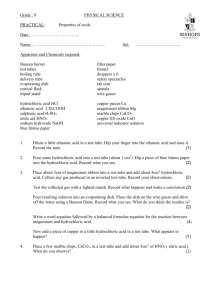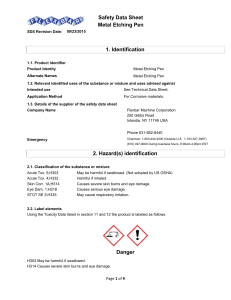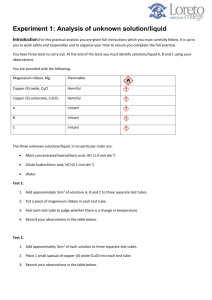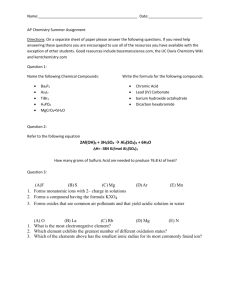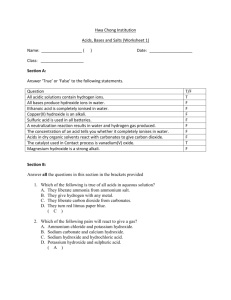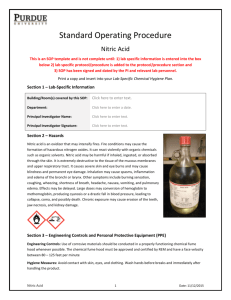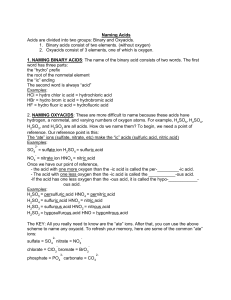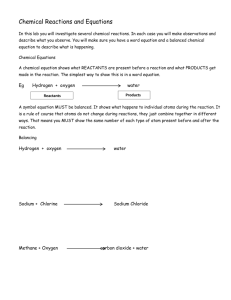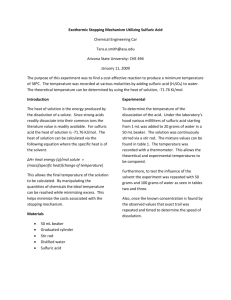Chemistry Lab Report
advertisement
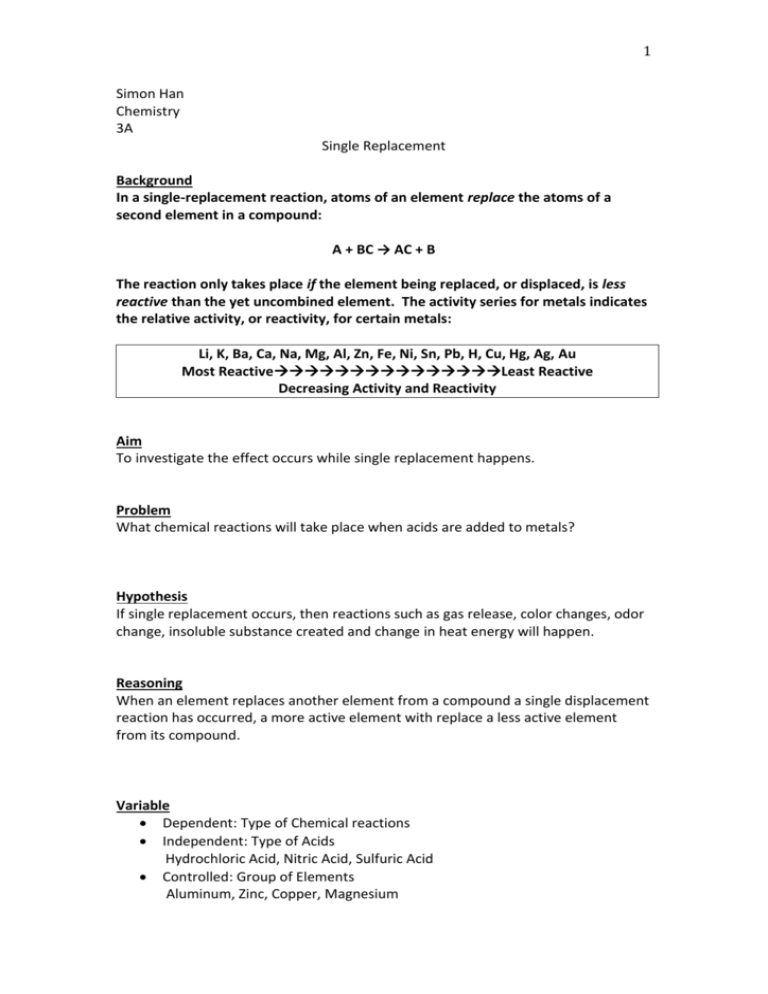
1 Simon Han Chemistry 3A Single Replacement Background In a single-replacement reaction, atoms of an element replace the atoms of a second element in a compound: A + BC → AC + B The reaction only takes place if the element being replaced, or displaced, is less reactive than the yet uncombined element. The activity series for metals indicates the relative activity, or reactivity, for certain metals: Li, K, Ba, Ca, Na, Mg, Al, Zn, Fe, Ni, Sn, Pb, H, Cu, Hg, Ag, Au Most ReactiveLeast Reactive Decreasing Activity and Reactivity Aim To investigate the effect occurs while single replacement happens. Problem What chemical reactions will take place when acids are added to metals? Hypothesis If single replacement occurs, then reactions such as gas release, color changes, odor change, insoluble substance created and change in heat energy will happen. Reasoning When an element replaces another element from a compound a single displacement reaction has occurred, a more active element with replace a less active element from its compound. Variable Dependent: Type of Chemical reactions Independent: Type of Acids Hydrochloric Acid, Nitric Acid, Sulfuric Acid Controlled: Group of Elements Aluminum, Zinc, Copper, Magnesium 2 Experimental Method Firstly, the safety equipment was required to be used; gloves, goggles, and aprons. Then the table was created to collect observation and evidence of the reaction. Each metal were cut about ½ of an inch and was put into the 24 well micro plates. The indirect method was when we cut the pieces of metal because we didn’t measure the metal. The metal were the control variable because we have to know what it looked before the experiment to get a conclusion. The formula is A + BC-> AC + B. Safety: We put on safety goggles and a lab apron in order to avoid acids splashing in to the eyes or clothes. We watched out to avoid breakage when working with glassware. Also we wore plastic disposable gloves when handling chemicals, as they may irritate the skin or stain skin or clothing. We avoided touching or tasting any chemical unless we were instructed to do so. After the experiment, we washed our hands with warm water and soap or detergent. Apparatus 3 Procedure WS- part II SINGLE REPLACEMENT REACTIONS 1. Some research were done on the single replacement reactions and got some background knowledge. 2. Put on goggles, apron, and gloves for safety issues and in case of some emergency. 3. Then, tables of the observations were made on excel on our computers. 4. Pictures were also taken throughout the lab. 5. The pictures taken were moved to the computers to be shared with the group members. 4 Data Collection Hydrochloric+Al Observations Permanent change in color Evidence Changed to green. Burnt, change color A permanent color change is observed and heat change. Color change A permanent color change is observed. Bubbling the moment it is touched. Burnt. Change colorblack A permanent color change is observed. No change No change Discolored, burnt, slightly warm Color darkened No change No change Discolored, formed bubbles Bubble were created, color change No change No change Bubbles surrounding, turned black Bubble were created, color change Color lightened Color had became lighter Release heat, continuous bubbles, water vapor, turned black on one side, and white on another, became harder Bubbles were created Hydrochloric+Zn Hydrochloric+Cu Hydrochloric+Mg Nitric+Al Nitric+Zn Nitric+Cu Nitric+Mg Sulfuric+Al Sulfuric+Zn Sulfuric+Cu Sulfuric+Mg 5 Hydrochloric Hydrochloric + Aluminum Hydrochloric + Copper Sulfuric Hydrochloric + Magnesium Nitric 6 Data Processing Analysis of result: Chemical Reactions Hydrochloric with Aluminum Analysis When these two substances react, there is a permanent change in color. The color changes to green. Hydrochloric with Zinc When HCL is added to Zinc, it burns and changes in color; there is also heat change. Hydrochloric with Copper A permanent color change was observed when these two substances were added together. Hydrochloric with Magnesium Bubbles were formed when two substances were touched. There was also a significant change in color. Nitric with Aluminum There were no changes. Something that we didn’t expect occurred. Nitric with Copper There were no changes occurred. Nitric with Magnesium When Nitric was added with copper, there were bubbles created and color change. Nitric with Zinc The color was darkened and the substance was heated. It was discolored burnt and went slightly warm. Sulfuric with Aluminum There were no changes observed. Sulfuric with Zinc Bubbles were created and there were color change. Sulfuric with Copper When these two substances are added together, the color lightens. Sulfuric with Magnesium There were releases of heat, continuous bubbles, and water vapor, turned black on one side, and white on another. It also became harder From the result, we can see that all the substances had shown some chemical reactions except Nitric with Aluminum, Nitric with Copper and Sulfuric with Aluminum. However, the reactions might be invisible, which can’t be observed with naked eyes. 7 Evaluation Conclusion: The hypothesis was partially correct. There were some metals that did not show any reactions. My experimental design (method): Generally the method seems to work well to get suitable results but part of it could be improved to get even better result. Limitation Threw the chemicals away after mixing down the sink. Improvement Ask for further instruction of disposal of chemical wastes. The aprons were torn. Use new aprons to ensure no chemicals are stained. Experiment under the same independent variable was only conducted three times. Repeat the same experiment 5~6 times. Reliability: Before starting the lab, we washed the 24-well Micro Plate to make sure that no substances are mixed unnecessarily. Also we cleaned, wiped and sanded all the metals before use. After every substance we mixed, we washed the plate with water and dried it. Result: The result was also generally satisfying that can support my hypothesis. However part of it seems to went wrong a little. When Nitric with Aluminum, Nitric with Copper and Sulfuric with Aluminum were added, there were no significant changes. One possible reason of this result is maybe because we don’t notice any changes through our naked eyes.
